[ad_1]
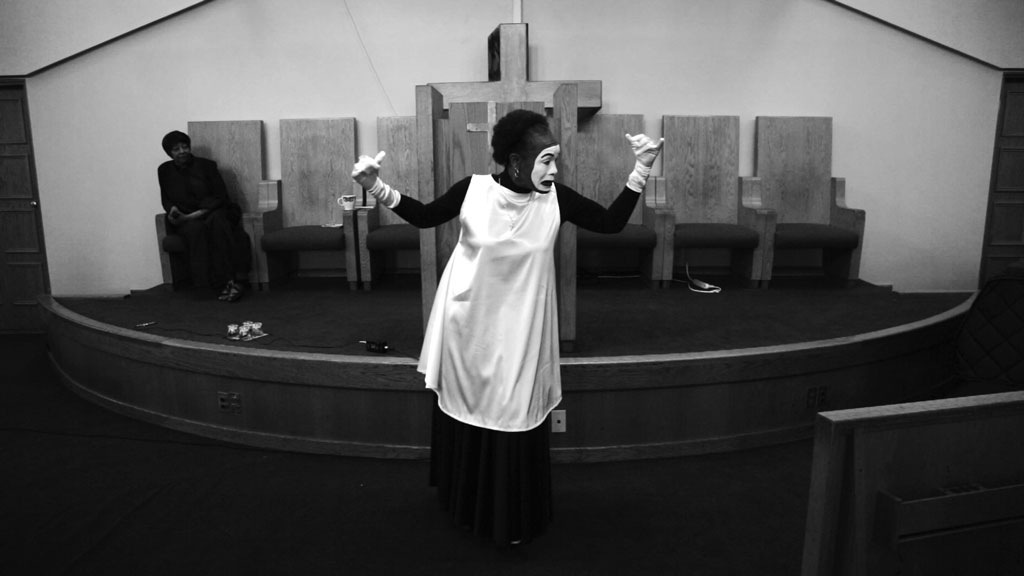
Steffani Jemison, Sensus Plenior, 2017, HD video. Whitney Biennial.
COURTESY THE ARTIST
This spring is shaping up to be a busy season one on the art calendar, with both the Whitney Biennial and the Venice Biennale opening within weeks of each other in May, and notable exhibitions taking place all over in the coming months, from a trailblazing survey of art after the Stonewall Rebellion to retrospectives for Lino Bo Bardi, Huma Bhabha, Luchita Hurtado, and El Anatsui, to biennials in Havana and Honolulu. And this is not even including gallery shows and—one hesitates to even say it—art fairs. Below, a look at the winter’s most promising museum shows and biennials.
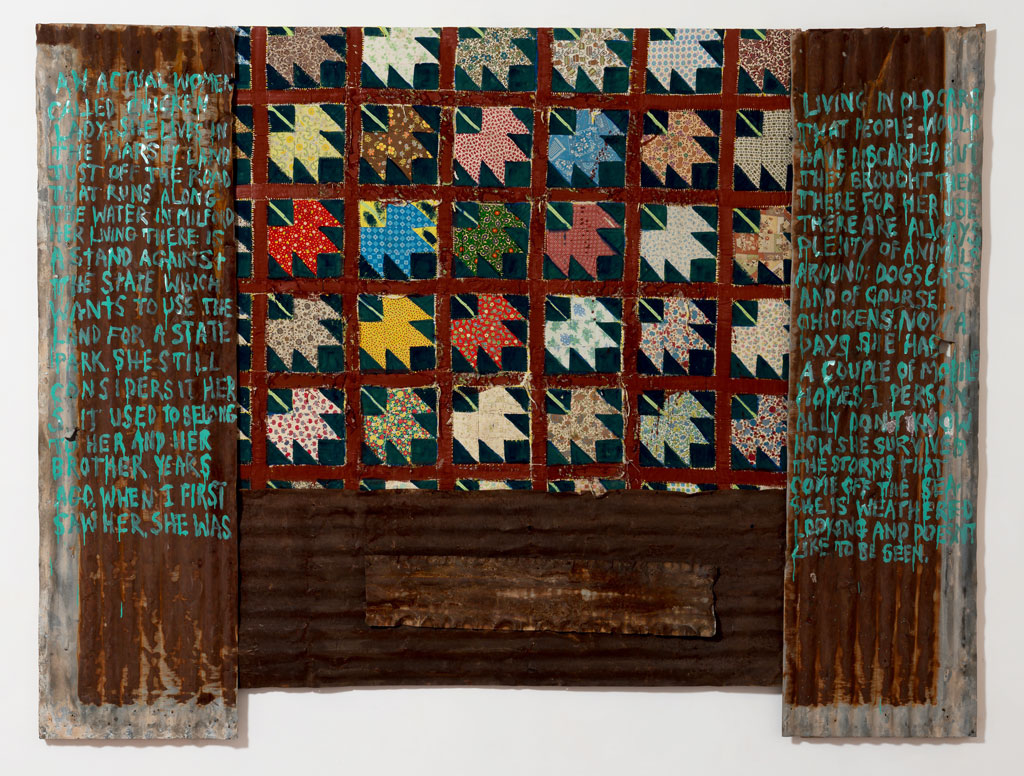
Harmony Hammond, Chicken Lady, 1989, quilt, canvas, acrylic and oil paint, corrugated roofing tin, three panels.
ERIC SWANSON/©2018 HARMONY HAMMOND, LICENSED BY VAGA AT ARTISTS RIGHTS SOCIETY (ARS), NY/COURTESY THE ARTIST AND ALEXANDER GRAY ASSOCIATES, NEW YORK
“Harmony Hammond: Material Witness, Five Decades of Art”
The Aldrich Contemporary Art Museum, Ridgefield, Connecticut
March 3–September 15
In the early 1970s, Harmony Hammond became a key figure in the feminist art movement for her bejeweled and braided canvases, which she has said offer a female perspective on her medium. Some of her early experiments feature in her first museum survey, with sculptures, paintings, and multimedia pieces created between 1971 and 2018. Among the works are Chicken Lady (1989), a mixed-media painting made with bits of quilt and recycled roofing tin that can be seen as signals of gender and class. —Claire Selvin
Honolulu Biennial
Various venues, Honolulu, Hawaii
March 8–May 5
Curated by Nina Tonga, the 2019 Honolulu Biennial will showcase work 47 artists and collectives exploring issues related to identity in the Pacific region. Titled “To Make Wrong / Right / Now,” in reference to a poem written by participating artist ‘Imaikalani Kalahele, the biennial includes sculptures by Abraham Cruzvillegas and an installation of Hawaiian flag tents by Bernice Akamine. Also planned for the biennial are over 90 free public programs, including workshops, open studios, and talks. —C.S.
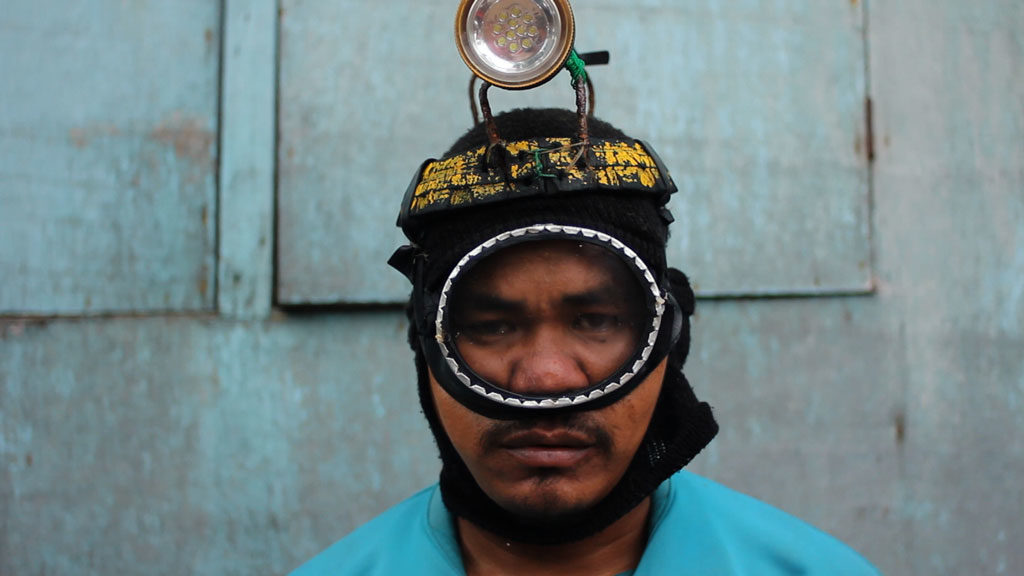
DAKOgamay, gilubong ang akong pusod sa dagat/My Navel is Buried in the Sea (still), 2011, video installation, HD video. Honolulu Biennial.
COURTESY THE ARTIST
“Charlotte Posenenske: A Work in Progress”
Dia:Beacon, New York
March 8–September 9
Following its acquisition of 155 works by Charlotte Posenenske, a figure who helps expand too-tidy notions of the Minimalist canon, the Dia Art Foundation has mounted a tribute to the late German artist at its postindustrial sanctuary in Upstate New York. Before she turned from art to study sociology in the late 1960s, Posenenske made works ranging from drawings to sculptural arrangements of prefab metal products that resemble surreal transfigurations of heating ducts in buildings that would otherwise rarely warrant a glance. Works of the kind are presented here in site-specific constructions, in the first North American retrospective of the artist, who died in 1985. —Andy Battaglia
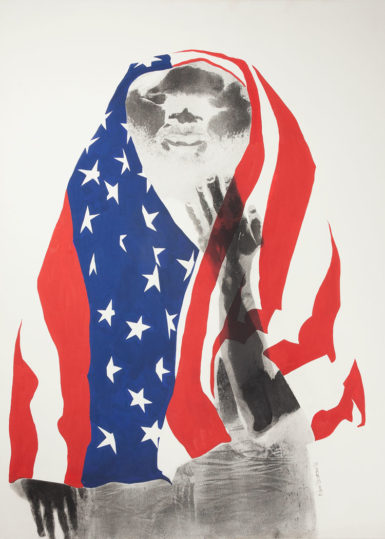
David Hammons, America the Beautiful, 1968, lithograph and body print. “Artists Respond.”
©DAVID HAMMON/OAKLAND MUSEUM OF CALIFORNIA
“Artists Respond: American Art and the Vietnam War, 1965–1975”
Smithsonian American Art Museum, Washington, D.C.
March 15–August 18
In 1970 artist Robert Morris made the Whitney Museum in New York close his own exhibition, partly as a response to the Vietnam War and the racism he said was involved. That was just one of the many radical ways that American artists at the time reacted to U.S. involvement in conflict abroad. Curated by Melissa Ho, this show surveys 58 American artists’ works dealing with the Vietnam War, and includes such pieces as Yoko Ono’s protest posters, David Hammons’s body prints, and Nancy Spero’s paintings of sexualized warcraft. Though the war ended in 1975, the Smithsonian will probe its lingering effects, and to complement the show, the museum is also exhibiting new works by Tiffany Chung about the war. —Alex Greenberger
“The World Between Empires: Art and Identity in the Ancient Middle East”
Metropolitan Museum of Art, New York
March 18–June 23
Some 300 hundred years of art and artifacts traded between the Roman and Parthian empires and ancient Middle Eastern peoples will be surveyed at this exhibition, which includes 190 wall paintings, sculptures, pieces of jewelry, and other objects. The show traces the histories of incense and silk routes that connected empires to form a global trading system and looks at how such exchanges influenced artistic styles. What could seem like an apolitical show has recently acquired a new context: some pieces come from archaeological sites in places that have been damaged or completely destroyed through destruction by ISIS or looting. —Annie Armstrong
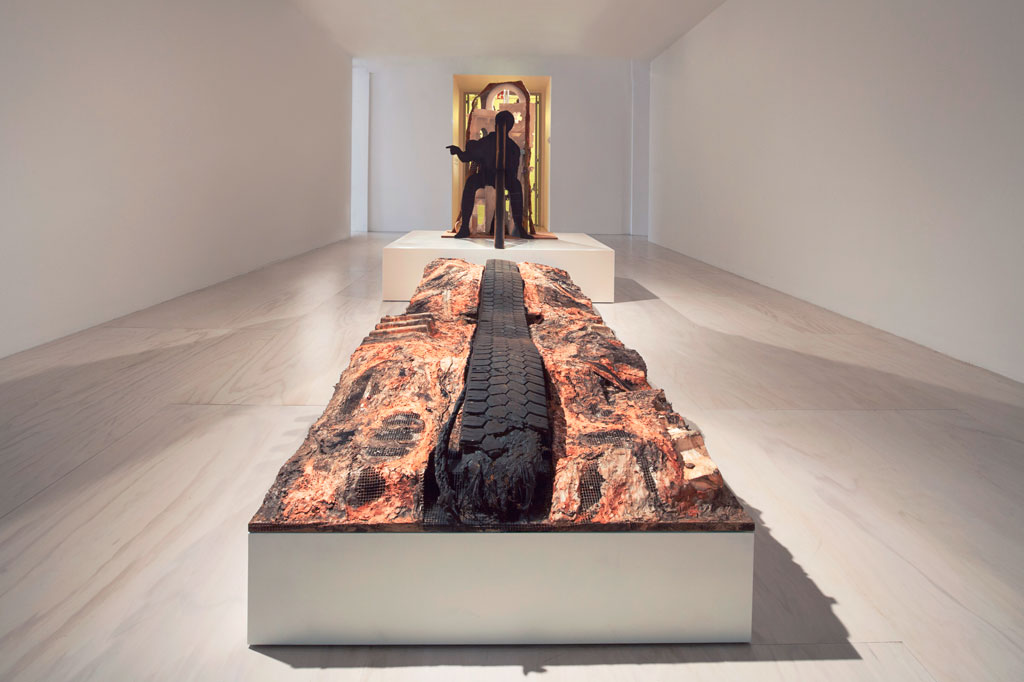
Huma Bhahba, Unnatural Histories, 2012, wood, wire, clay, wire mesh, Styrofoam, acrylic paint, oil stick, burlap, metal, lucite, feathers, paper, laces, rubber, plastic, and horn.
©HUMA BHABHA/COURTESY THE ARTIST AND SALON 94, NEW YORK
“Huma Bhabha: They Live”
Institute of Contemporary Art, Boston
March 23–May 27
The sci-fi spirit of Huma Bhabha’s sculpture project on the roof of the Metropolitan Museum of Art last summer—an alien visitation by an extraterrestrial standing 12 feet tall with a veiled figure bowing before it—courses through much of the artist’s photography, drawings, and sculpture. Included here in her largest show to date are works that meditate on what Bhabha has designated as “eternal concerns”—war, colonialism, and otherness. —Shirley Nwangwa
“The Body Electric”
Walker Art Center, Minneapolis
March 30–July 21
“Technology has become the body’s new membrane of existence,” artist Nam June Paik once said. Working with this spirit in mind, curators Pavel PyŚ and Jadine Collingwood conceived this survey of artists who ponder the relation between people and the technology that surrounds them. The show includes members of an older generation—Charlotte Moorman and Shigeko Kubota among them—and juxtaposes their work with that of promising young artists including Paul Mpagi Sepuya, Candice Lin & Patrick Staff, and Andrea Crespo. —A.G.
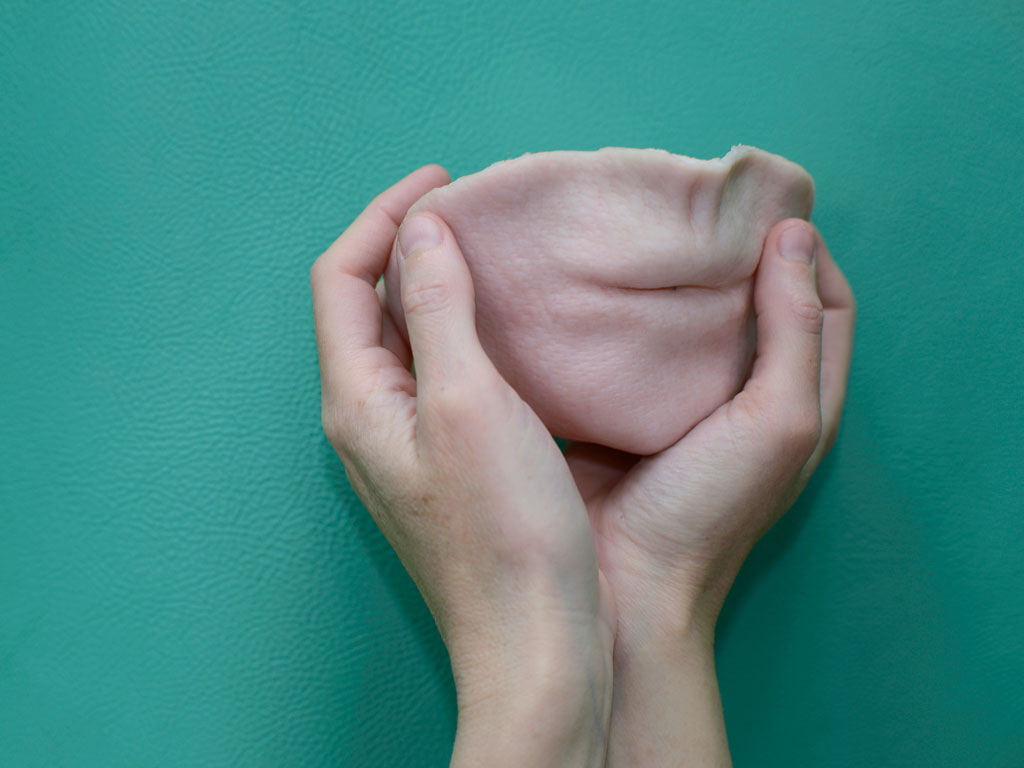
Aneta Grzeszykowska, Selfie #17, 2014, pigment ink on cotton paper. “The Body Electric.”
COURTESY RASTER GALLERY, WARSAW
“Simone Fattal: Works and Days”
MoMA PS1, New York
March 31–September 2
Touted as the first U.S. solo museum show for Simone Fattal, who started painting in 1969, this career-spanning survey features more than 100 sculptures, canvases, and collages by the artist born in Syria, raised in Lebanon, and based in Paris. Often taking the form of lumpy sculptures and squat ceramics, her work can resemble artifacts from historically distant people dug up in the present day—an effect that Fattal has said reflects the displacement she has felt as a foreign-born artist living in Europe. —S.N.

Peter Paul Rubens, Daniel in the Lions’ Den, ca. 1614/1616, oil on canvas.
COURTESY THE FINE ARTS MUSEUMS OF SAN FRANCISCO/NATIONAL GALLERY OF ART, WASHINGTON D.C.
“Early Rubens”
Legion of Honor, San Francisco
April 6–September 8
This blockbuster aims to offer an origin story of sorts for Peter Paul Rubens through 30 paintings and 20 prints he made between 1608 and 1621. Organized in collaboration with Canada’s Art Gallery of Ontario, the show traces the early part of Rubens’s career, which saw the painter studying in Italy and reinterpreting the outré compositions of Mannerist painting for Dutch and Flemish patrons. Some of the finest paintings by Rubens held by museums are traveling for the show; one such work is the National Gallery of Art in Washington, D.C.’s Daniel in the Lions’ Den (1614/16). —A.G.
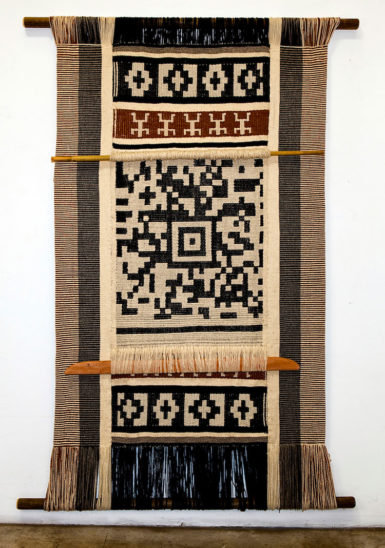
Guillermo Bert, The Visionary, 2012, yarn, natural dyes, and wood. “Mundos Alternos.”
COURTESY THE ARTIST/NEVADA MUSEUM OF ART
“Mundos Alternos: Art and Science Fiction in the Americas”
Queens Museum, New York
April 7–August 18
Bringing together artists from throughout the Caribbean, continental Latin America, and the United States, “Mundos Alternos” looks at the ways in which artists from these regions use science fiction to imagine and create alternate realities and spaces, utopian and dystopian alike. While an iteration of the exhibition first debuted UCR Arts in Riverside, California, as part of the Getty Foundation–funded Pacific Standard Time: LA/LA exhibition initiative in 2017, the 50-work version presented in New York’s largest borough will seek to connect more specifically with the city’s immigrant populations and Latinx arts scene, as well as connecting with partner institutions throughout the city that will show sections of the exhibition. Beatriz Cortez, Clarissa Tossin, and Glexis Novoa will present new work, while a series of performances, screenings, and workshops is rounded out by the likes of Coco Fusco, Guillermo Gómez-Peña, and Carmelita Tropicana. —Maximilíano Durón
“Jonathas de Andrade: One to One”
Museum of Contemporary Art, Chicago
April 13–August 25
The subjects of Jonathas de Andrade’s work are “urgencies and discomforts,” as the artist has put it—issues related to identity, labor, and colonialism, specifically as they impact Brazil, where the artist is based. A frequent subject in his work is intimacy: his 2016 video O Peixe (The Fish) appears at first to be an ethnographic film about the fishing industry in Brazil, then slowly reveals itself to be a tender allegorical work about the relationship between workers and what they produce. Having been featured in recent editions of the Bienal de São Paulo and Performa, the artist’s work will be surveyed in this show. —A.G.
“The American Pre-Raphaelites: Radical Realists”
National Gallery of Art, Washington, D.C.
April 14–July 21
Some 90 paintings, watercolors, and drawings from the Victorian era are to be included in this exhibit, held to commemorate the 200th anniversary of John Ruskin’s birth. The critic was known for calling on artists to reject traditional academic art practices, once writing, “Remember that the most beautiful things in the world are the most useless; peacocks and lilies for instance.” But that’s no reason to dismiss these rapturous pieces—by artists such as Thomas Charles Farrer and Charles Herbert Moore—as being merely beautiful. Keep an eye out for coded references to Civil War–era political happenings. —A.A.
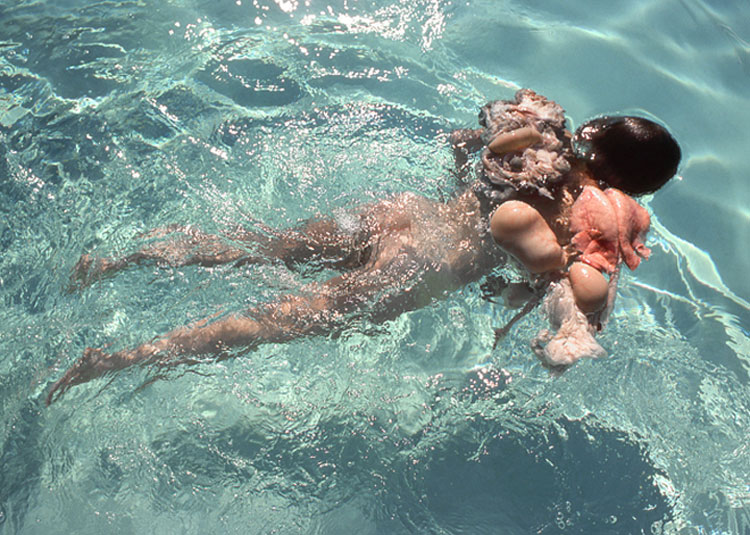
Suzanne Lacy, Anatomy Lesson #4 Swimming (detail), 1977, four color photographs.
ROB BLALACK/©SUZANNE LACY
“Suzanne Lacy: We Are Here”
San Francisco Museum of Modern Art and Yerba Buena Center for the Arts
April 20–August 4
In her socially engaged projects, beginning in the 1970s, Suzanne Lacy has taken on issues such as labor rights and misogynistic violence. Now she receives her first retrospective after a career’s worth of influential performances, videos, photographs, and immersive installations. In tribute to her experimental style—which is often geared around conversations and interactions—this two-venue retrospective will feature live activations of Lacy’s work from the past. —A.A.
“Art After Stonewall, 1969–1989”
Grey Art Gallery and Leslie-Lohman Museum of Gay and Lesbian Art, New York
April 24–July 20
While much has been written on the enduring legacy of the Stonewall Rebellion, the 50th anniversary of which falls in June, this exhibition will look at the still underrecognized impact that night’s activism had on the art world, both in New York and beyond. Organized by the Columbus Museum of Art in Ohio and debuting at these two venues in New York, the survey aims to break new ground in queer-art scholarship. It brings together over 200 works by numerous openly queer-identified artists, including heavyweights like Vaginal Davis, Lyle Ashton Harris, Catherine Opie, Thomas Lanigan-Schmidt, Greer Lankton, Harmony Hammond, and Robert Mapplethorpe, who are paired alongside artists who have sidelined by history. The exhibition will track the two decades in its scope focusing on poignant themes, including “Coming Out,” “Sexual Outlaws,” “Gender and Body,” and “AIDS and Activism.” —M.D.

Peter Hujar, Daniel Ware (Cockette), 1971, gelatin silver print. “Art After Stonewall, 1969–1989.”
©1987 THE PETER HUJAR ARCHIVE LLC/COURTESY PACE/MACGILL GALLERY, NEW YORK, AND FRAENKEL GALLERY, SAN FRANCISCO
“Deborah Anzinger: An Unlikely Birth”
Institute of Contemporary Art, Philadelphia
April 26–August 11
The Jamaican artist Deborah Anzinger makes use of a range of materials, both natural and synthetic, in work that looks at ecology and geography from a black feminist perspective. Curated by Daniella Rose King, the artist’s first solo museum exhibition in America will consist of painting, sculpture, video, and installation, with previous works shown alongside new commissions of varying scale. Using acrylic, mirror, and synthetic hair on canvas, An Unlikely Birth (2018), the show’s titular painting, is one example of how the artist wields abstraction and unconventional materials to underscore a larger socio-political concern—in this case, the plantation’s role in the development of capitalism. —J.C.
“Sondra Perry: A Terrible Thing”
Museum of Contemporary Art, Cleveland
April 27–August 11
Gelatinous fluids and glitchy avatars frequently figure in video installations by Sondra Perry, who was named the first winner of moCa Cleveland’s Toby’s Prize last year. Both are likely to play a role once again in Perry’s new moving-image work, which will ponder the exploitation of black labor in the museum world. To make the work, Perry researched the process of blacksmithing and the chemical processes that occur when human flesh touches metal. —A.G.
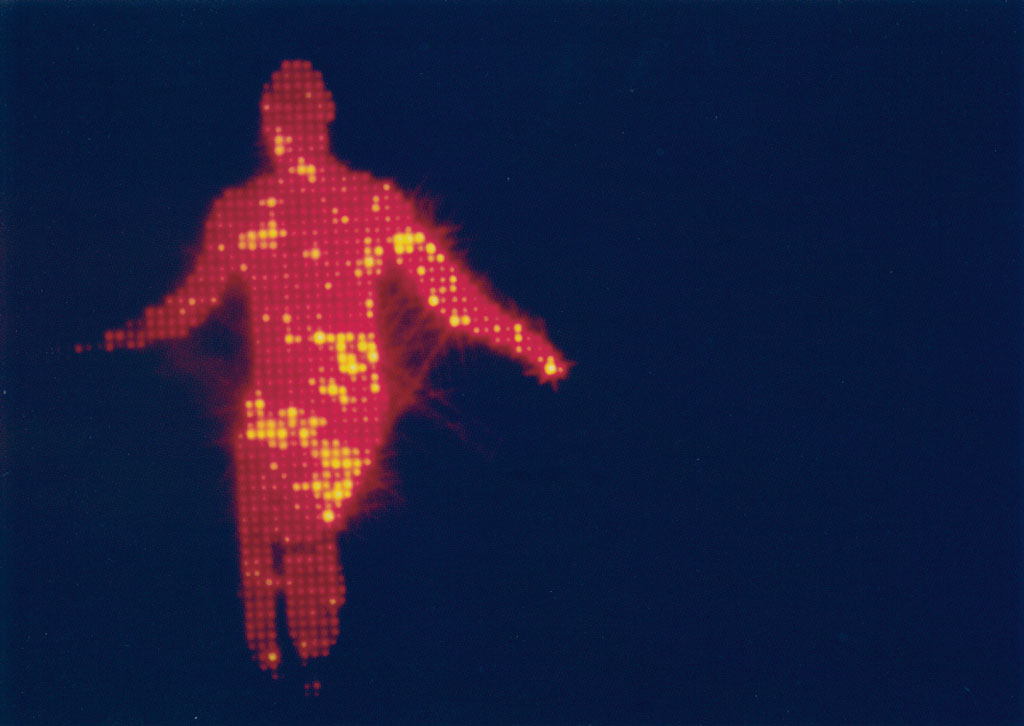
Jack Goldstein, The Jump (still), 1978, 16mm film, silent projection, and two black light tubes. “Disappearing California.”
©THE ESTATE OF JACK GOLDSTEIN
“Camp: Notes on Fashion”
Metropolitan Museum of Art, New York
May 9–September 8
For its annual spring exhibition, the Met’s Costume Institute will ponder the idea of camp, which was made famous by writer Susan Sontag’s landmark 1964 essay “Notes on ‘Camp.’ ” Camp was—and continues to be—a sensibility, aesthetic, and language that is distinctly queer—a private form of communication that deals in excess and parody. In some 200 objects, the exhibition will chart various modes of camp from 17th-century Versailles to queer subcultures of late 19th- and early 20th-century Europe and America to today. Surveyed designers include Elsa Schiaparelli, Yves Saint Laurent, Cristóbal Balenciaga, Christian Dior, Bob Mackie, Vivienne Westwood, Jean Paul Gaultier, John Galliano, and the late Karl Lagerfeld. –M.D.
“Disappearing—California, c. 1971: Bas Jan Ader, Chris Burden, Jack Goldstein”
Modern Art Museum, Fort Worth, Texas
May 10–August 11
All three of these artists were active in Southern California in the 1970s, and all held a shared interest in creators going missing. That was particularly the case in Burden’s 1971 work Disappearing, for which he disappeared for three days and never told anyone were he went; Ader likewise vanished somewhere in the Atlantic Ocean during the making of this final piece in 1975. Curated by Philipp Kaiser, the exhibition will survey the overlapping themes within each artist’s practice, as well as their contributions to California conceptualism. Kaiser will relate their work to the Vietnam War, California’s military infrastructure, and the rise of the feminist art movement. –M.D.
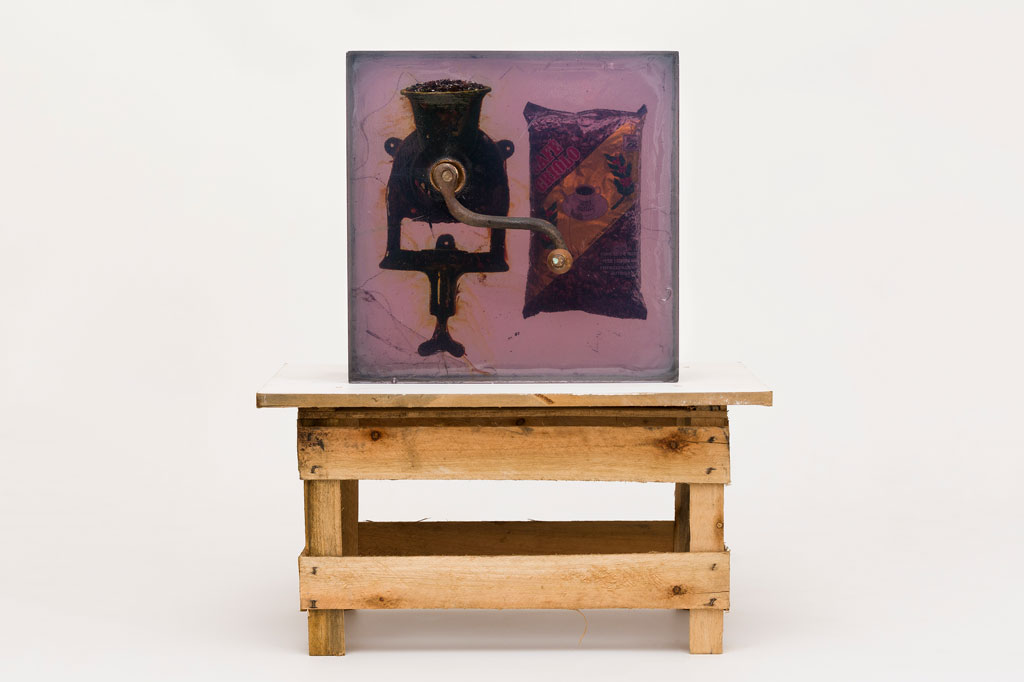
Paulo Nazareth, CA – genocide products- Planeta Criolo, 2018.
COURTESY THE ARTIST AND MENDES WOOD DM, SÃO PAULO
Paulo Nazareth
Institute of Contemporary Art, Miami
May 16–October 6
Nazareth’s work in various mediums—video, sculpture, drawing, installation—often looks at histories of various communities, in particularly indigenous, black, and Afro-Latinx ones, throughout the Americas, and shows how they’ve intersected with colonialism, genocide, and civil-rights activism. For his first solo exhibition at an American institution, the Brazilian artist will present recent work, including a project where he visited various sites of the Underground Railroad, alongside new drawings that look at segregation in the United States. —M.D.
“Whitney Biennial 2019”
Whitney Museum, New York
May 17–September 22
The last Whitney Biennial, in 2017, garnered rave reviews, bitter protests, and still-resonating debates about works on view. The follow-up, curated by the Whitney’s own Rujeko Hockley and Jane Panetta, will aim once again to survey American art through work by 75 artists, among them Nicole Eisenman, Christine Sun Kim, Janiva Ellis, James Luna, and many more. Already anticipation has been tempered by controversy, with the activist group W.A.G.E. urging participants in the exhibition to consider withholding their work over reports that the Whitney’s vice chair, Warren B. Kanders, owns a company that manufactures law enforcement and security products—including tear gas canisters and smoke grenades—used against asylum seekers along the U.S.-Mexico border. —A.G.

Laura Ortman, My Soul Remainer, 2017, HD video.
COURTESY THE ARTIST
Paul Mpagi Sepuya
Contemporary Art Museum, St. Louis
May 17–August 18
Cut-up, rearranged, reshot, and edited images of bodies—many of them belonging to queer black men—are the subject of Paul Mpagi Sepuya’s photography, which, following appearances at various notable venues, including the Museum of Modern Art’s 2018 “New Photography” show, has made him one of the most closely watched young American artists. On the same day his pictures appear at the Whitney Biennial, CAM St. Louis will open a survey of the Los Angeles–based artist’s work. Included will be examples of one of his most recent series, which makes use of mirrors in an inquiry into the power dynamics of taking pictures. —A.G.
“Cauleen Smith: We Already Have What We Need”
MASS MoCA, North Adams, Massachusetts
Opens May 25
Upon entering the 2017 Whitney Biennial, visitors immediately saw a series of banners by Cauleen Smith. Adorned with phrases written in cursive such as “I’m so black that I blind you” and “Rage looms within me,” they acted as protest signs and assertions of Smith’s presence as a black woman within a traditionally white space. Some of these works are to be featured in this show, which is being billed as Smith’s most comprehensive exhibition to date. Spanning MASS MoCA’s entire first floor, the show also includes a series of drawings about literature related to “black fugitivity” and a new video installation about the relationship between viewers and the natural world. —A.G.

Cauleen Smith, Remote Viewing (still), 2009, HD video.
COURTESY THE ARTIST; KATE WERBLE, NEW YORK; AND CORBETT VS. DEMPSEY, CHICAGO
“Manet and Modern Beauty”
Art Institute of Chicago
May 26–September 8
Several decades into his career, after years of scandal, Manet had received critical acclaim for painting provocative pictures of modern French life and all its changing sexual mores. Having achieved considerable attention for his shock tactics, he embarked on a more experimental phase during the 1870s—a period surveyed in this blockbuster show, which focuses on the end of Édouard Manet’s career. On view will be portraits of the artist’s friends, muses, and his wife, as well as late-career masterpieces like Boating (1874), a placid scene showing a couple in a Parisian suburb rendered through brushy strokes. —A.A.
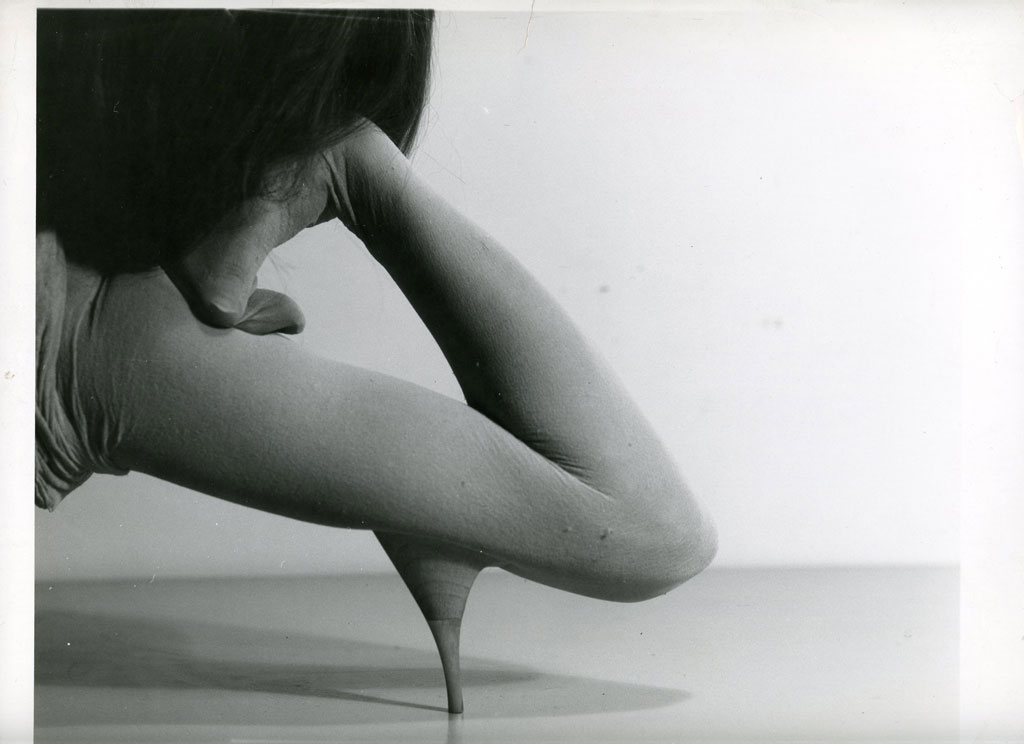
Birgit Jürgenssen, Schuhroulade / Shoe Roulade, 1977, black-and-white photograph.
©2019 ESTATE BIRGIT JÜRGENSSEN, SIAE/COURTESY GALERIE HUBERT WINTER, VIENNA/PRIVATE COLLECTION, VIENNA
“Birgit Jürgensson: Io Sono”
Galleria d’Arte Moderna e Contemporanea, Bergamo, Italy
March 7–May 19
The first Italian institutional exhibition devoted to the late Austrian feminist artist Birgit Jürgensson is a blowout: it will take over every room of the museum and include in excess of 150 works, among them drawings, collages, sculptures, photographs, and more. Jürgensson is perhaps best known for work that challenged her day’s dominant modes of feminine expression. As the artist’s career developed, so did her interests: her later work expanded to address the role of nature and culture in the broader concepts of identity. —J.C.
“Civilization: The Way We Live Now”
Ullens Center for Contemporary Art, Beijing
March 9–May 19
Taking its name from a book by Niall Ferguson, “Civilization” surveys more than two decades of recent photo-based work focused on the seemingly endless possibilities—and the utter sameness—of a world where anything and everything is available, thanks to our phones, Amazon, and social media. The more than 250 works on view touch on a spread of subject matter, including wealth disparities, community, and symbolic capital. An-My Lê, Penelope Umbrico, Amalia Ulman, Mishka Henner, and Thomas Struth are just a few of the artists included in the star-studded show. —A.G.
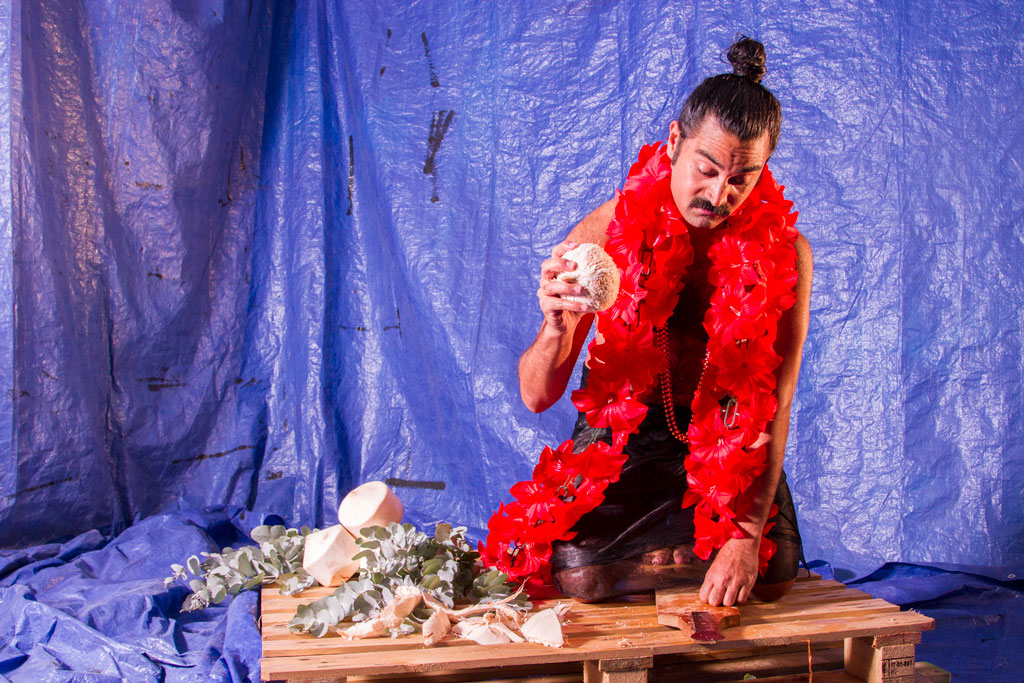
Léuli Eshrāghi, tagatanuʻu, 2017, performance view, Open Space, Victoria, Canada. Sharjah Biennial.
CLAYTON WINDATT/COURTESY THE ARTIST
Sharjah Biennial
Various venues, Sharjah, United Arab Emirates
March 7–June 10
Titled “Leaving the Echo Chamber,” the 14th Sharjah Biennial aims to address a wide range of topics including the flow of ideas and governmental control of information. Its heady ideas figure in three mini-shows curated by Zoe Butt, Omar Kholeif, and Claire Tancons, who commissioned artists Tuan Andrew Nguyen, Lawrence Abu Hamdan, Candice Breitz, and many others to produce new works for the exhibition. —C.S.
“El Anatsui: Triumphant Scale”
Haus der Kunst, Munich
March 8–July 28
For the largest show of El Anatsui’s work to date—curated by Okwui Enwezor and Chika Okeke-Agulu—the Haus der Kunst commissioned new sculptures for its monumental facade and selected other works including ceramics, wood sculptures, paintings, prints, and books by the artist born in Ghana in 1944. Anatsui’s signature Klimt-like curtains of bottle caps woven together appear in the show, in what the artist has said are allusions to commercial trade and postcolonial exchanges across cultures. So, too, do vividly colored works that link child’s play and modernist design, the local and the global, dumpster detritus and high-end conceptions. —Barbara A. MacAdam
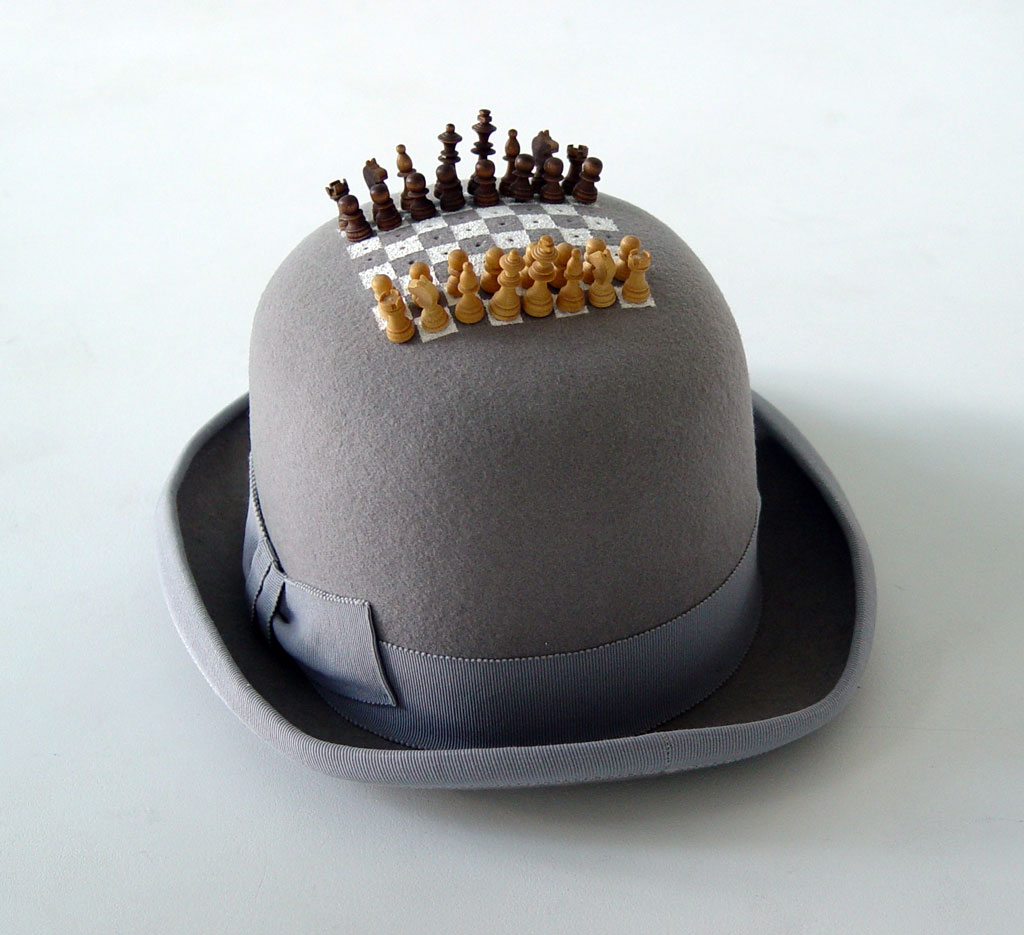
Takako Saito, Hutschachspiel, 1990.
K. VAN GELDER/©2019 TAKAKO SAITO AND ADAGP, PARIS/COURTESY GALERIE VAN GELDER AMSTERDAM
Takako Saito
CAPC Musée d’Art Contemporain, Bordeaux, France
March 8–September 22
Coinciding with the artist’s 90th birthday, this retrospective brings together more than 400 pieces—including sculptures, paintings, sound works, and books—created by Takako Saito throughout the course of her career. Objects on view will range from Saito’s early works inspired by board games to her new clothing designs. Saito, who was a member of the avant-garde collective Fluxus during the 1960s, will give three performances as part of the exhibition. —C.S.
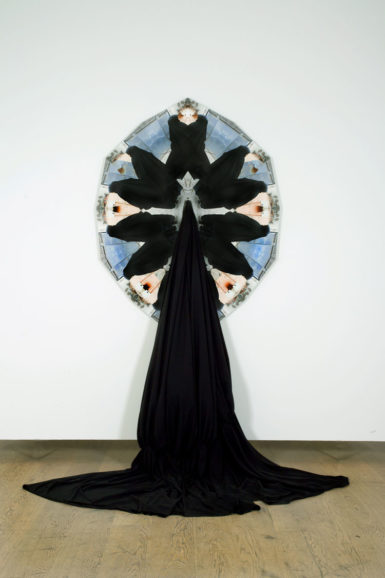
Nil Yalter, Untitled (Black Veil), 2018, photographs on Alu Dibond and polyester fabric.
REHA ARCAN/©NIL YALTER/COURTESY THE ARTIST AND GALERIST, ISTANBUL
“Nil Yalter: Exile Is a Hard Job”
Museum Ludwig, Cologne
March 9–June 2
The 81-year-old Turkish artist Nil Yalter has appeared recently in the Gwangju Biennale and the Istanbul Biennial, and now counts as the subject of this survey of her feminist work dating back to the 1960s and ’70s. Among the paintings, collages, and videos on view is the video The Headless Woman and the Belly Dance (1974), in which Yalter inscribes a poem on her body as a reflection of the male gaze. —J.C.
“Thomas Houseago: Almost Human”
Musée d’Art Moderne de la Ville de Paris
March 15–July 14
Thomas Houseago’s first retrospective in France features works made over the past three decades. Houseago is best known for his monumental sculptures of contorted human figures made from a variety of materials, including wood, plaster, iron, and bronze. Each of these sculptures is imbued with an air of foreboding, mystery, and disquiet. Striding Figure II (Ghost), 2012, will be displayed on the esplanade of the Musée d’Art Moderne de la Ville. Other highlights include Cast Studio (stage – chairs – bed – mound – cave – bath – grave), an installation created specially for this presentation, and the artist’s “Black Paintings” series (2015–16). —C.S.
“And Berlin Will Always Need You: Art, Craft, and Concept Made in Berlin”
Martin-Gropius-Bau, Berlin
March 22–June 16
This show takes its name from a song once sung by the artist Dorothy Iannone to a friend, and uses the phrase to ponder “interpretation, authorship, labor, sovereignty, and power structures” in Berlin’s contemporary art world, according to the museum. The wide-ranging survey of craft and handmade objects in German art, which itself is situated in a former decorative arts museum, includes abstract works spun from natural fibers by Olaf Holzapfel, a screen composed of found carpets by Nevin Aladağ, and a video installation by Theo Eshetu. —A.A.
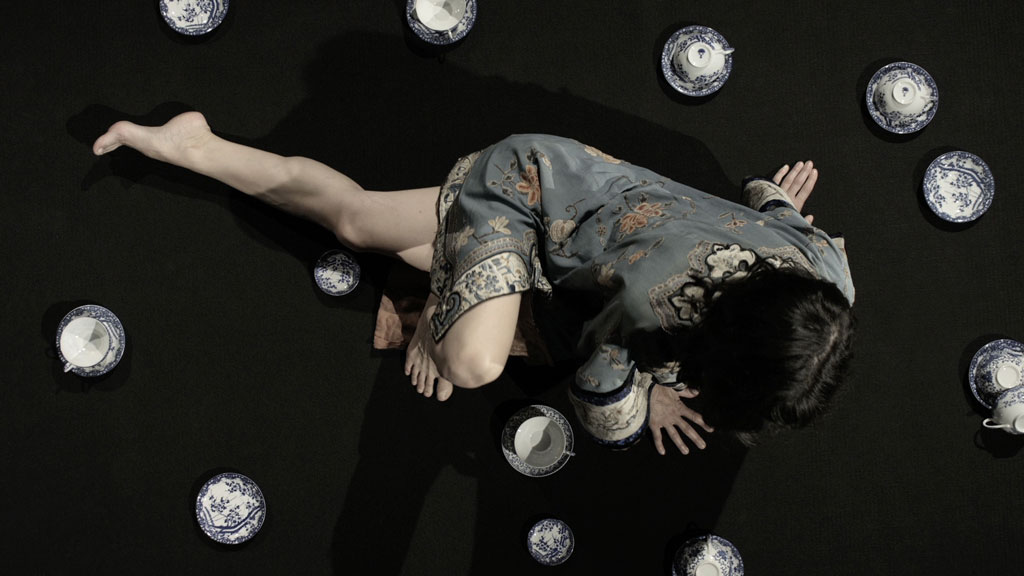
Simon Wachsmuth, Qing, 2016, two-channel video projection, showcases with archive materials: family photos, archive pictures, and textiles. “And Berlin Will Always Need You.”
©2019 SIMON WACHSMUTH AND VG BILD-KUNST, BONN/COURTESY THE ARTIST AND GALERIE ZILBERMAN, BERLIN AND ISTANBUL
“A World of Their Own: Modern Argentine Photography 1927–1962”
Museo de Arte Latinoamericano de Buenos Aires
March 22–June 9
Photography has been part of Argentina’s national identity since around the time of its independence. In the mid-19th century, photographers documented the customs of people in the country in daguerreotypes, for example. Taking 1927 as a demarcation of a significant shift, this exhibition will examine the development of a photographic avant-garde in Argentina, looking at the ways some 25 artists sought to move the form past the documentary impulses of the camera toward a new mode of expression. The show will survey some 200 works by some of the best-known photographers from the period, including Horacio Coppola, Grete Stern, and Annemarie Heinrich, with lesser-known ones. —M.D.
“The National: New Australian Art 2019”
Various venues, Sydney
Opens March 29; closing dates vary
The second installment of a three-part, six-year initiative is a survey of contemporary Australian art featuring work by 48 artists in three venues in Sydney: the Art Gallery of New South Wales, Carriageworks, and the Museum of Contemporary Art Australia. Established artists mingle with up-and-comers in the collective exhibition organized by curators from the respective institutions. Among the artists showing are Abdul-Rahman Abdullah, Agatha Gothe-Snape, and Amala Groom. —J.C.
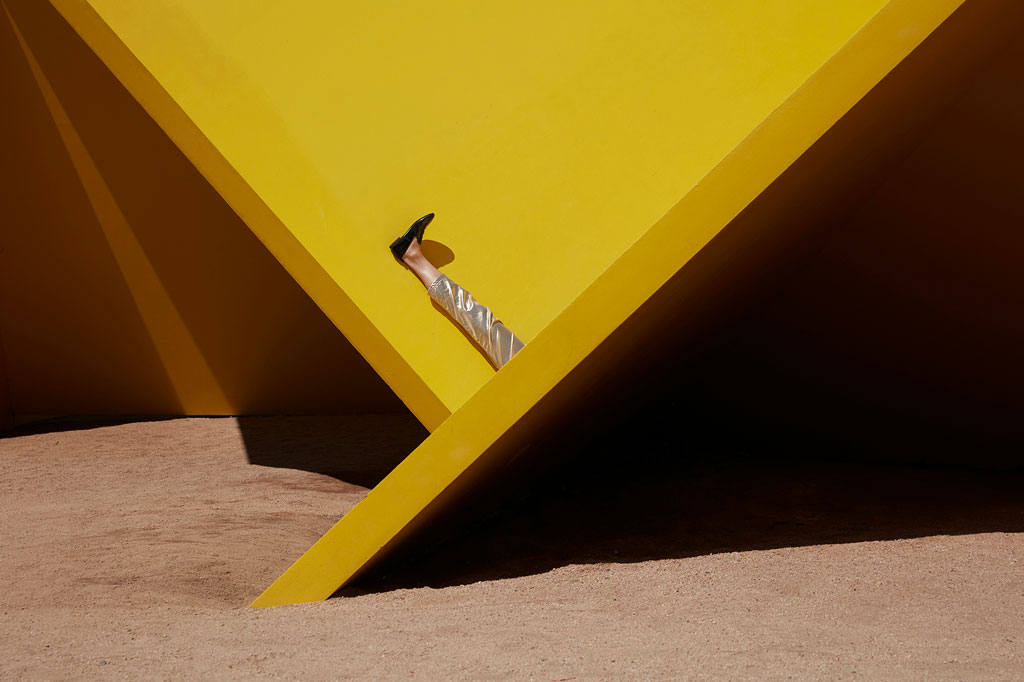
Eugenia Lim, The Australian Ugliness (still), 2018, multichannel HD video installation. “The National.”
TOM ROSS/©EUGENIA LIM/COURTESY THE ARTIST
“Ernesto Neto: Sopro [Blow]”
Pinacoteca do Estado de São Paulo
March 30–July 15
For Ernesto Neto’s 1989 sculpture Copulônia, fabric structures weighted with lead are strewn around and hung from the ceiling, their forms becoming strangely organic-looking in the process. The work will play a central role in Neto’s Pinacoteca retrospective, where the piece will be enacted by performers eight times over the show’s run. Curated by Jochen Volz and Valeria Piccoli, it will include some 60 other works alongside it, among them Neto’s recent collaborations with indigenous peoples across Brazil that examine the role of ritual in the contemporary world. —A.G.
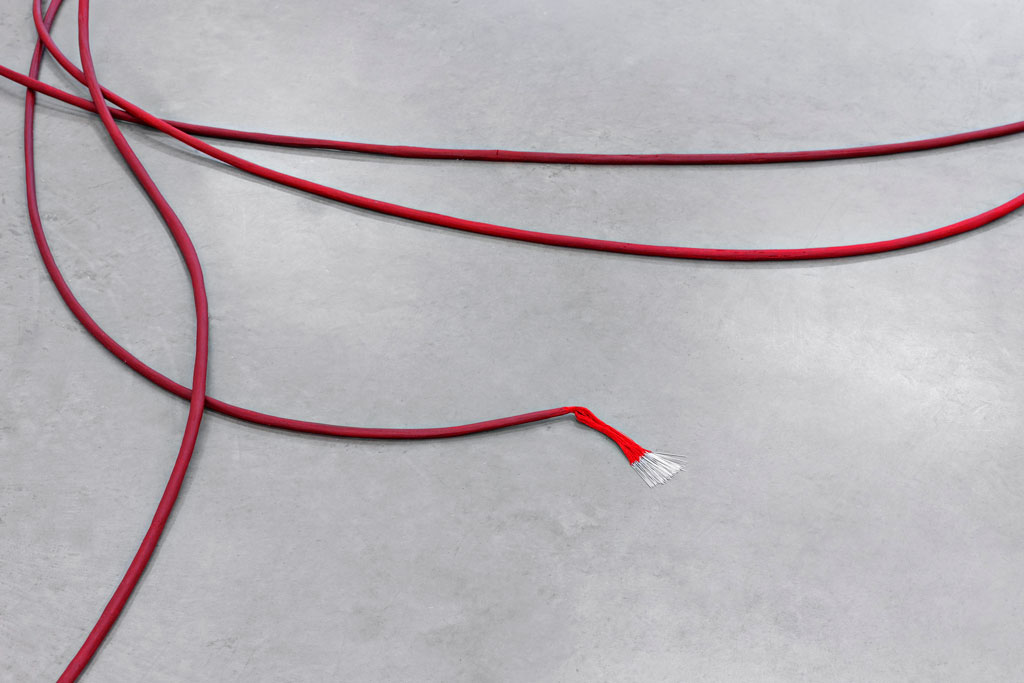
Sheela Gowda, And… (detail), 2007.
VEGARD KLEVEN, OCA/COURTESY THE ARTIST AND OFFICE FOR CONTEMPORARY ART NORWAY (OCA), OSLO
“Sheela Gowda: Remains”
Pirelli HangarBiccoca, Milan
April 4–September 15
One of the most celebrated names in Indian contemporary art, Sheela Gowda connects formal tenets of European modernism with traditions from her local culture, the result being a fusion of influences that alludes to ritual and the art-historical canon in equal measure. For her first exhibition in Italy, Gowda presents a new work alongside art made over the past couple decades. The show includes watercolors, prints, and site-specific installations that comprise an eclectic list of materials, including hair, cow dung, incense, and natural pigments. —J.C.
“Lina Bo Bardi: Habitat”
Museu de Arte de São Paulo
April 5–July 28
One could say this exhibition was encoded in its site’s DNA, since Lina Bo Bardi—an Italian-born architect who translated European modernist styles for Brazilian audiences—designed the Museu de Arte de São Paulo and fashioned its signature open-floor plan and heavy concrete beams. Alongside her work focused on building and design, MASP will showcase Bo Bardi’s role in Habitat, a magazine that became a fixture of the São Paulo art scene, thanks to its incisive criticism on art and architecture. —A.G.
“Maria Lassnig — Ways of Being”
Stedelijk Museum, Amsterdam
April 6–August 11
Maria Lassnig, the unfathomably brave, inventive Austrian painter who died in 2014, aged 94, will get a retrospective for the first time in the Netherlands. Her bright-hued portraits and self-portraits celebrate the body as absurd, surprisingly strong, and uncannily beautiful, even (or especially) when it is quite gross. Always, strange psychological states seem to be bursting through skin. It’s reasonable to assume that in some future age her paintings will be used to illustrate our manic times. For now, they provide a measure of comfort to us. The facts: 200-plus works (a bounty) plus the final piece she ever made depicting herself. —Andrew Russeth
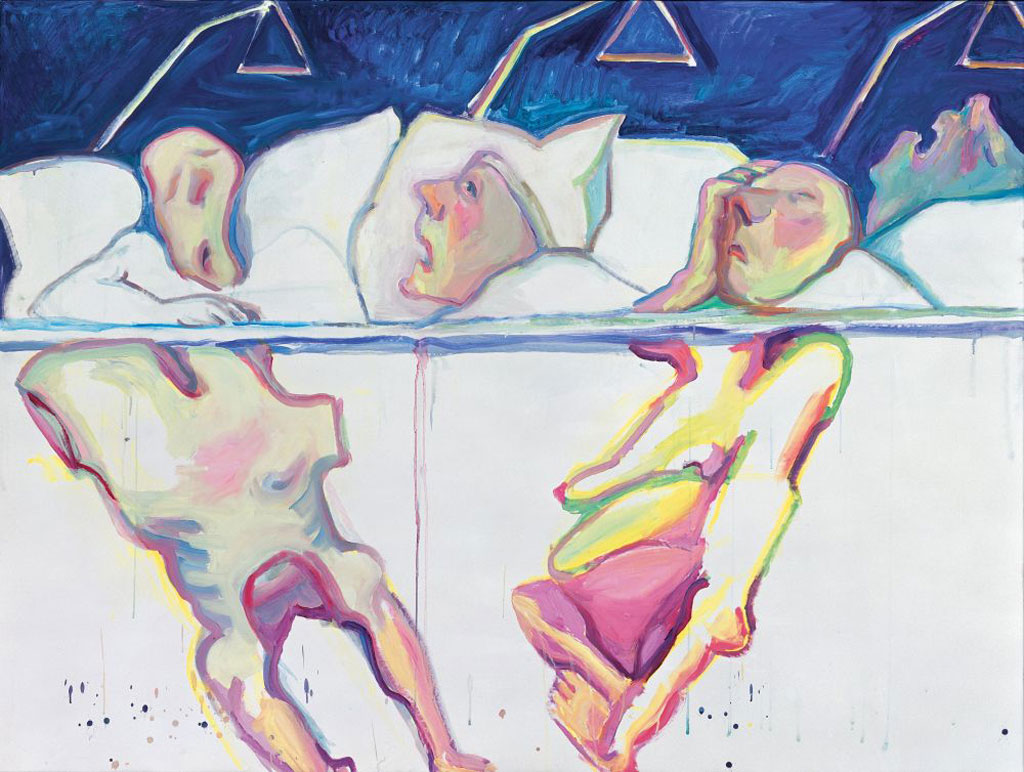
Maria Lassnig, Krankenhaus, 2005.
COURTESY HAUSER & WIRTH COLLECTION SERVICES/PRIVATE COLLECTION
“Tetsuya Ishida: Self-Portrait of Other”
Reina Sofia, Madrid
April 11–September 6
Though only active for around ten years, the late Japanese artist Tetsuya Ishida created a robust collection of work exploring the hardships the everyday Japanese person faced during his lifetime. But to address real-world issues, Ishida, who died at age 31 in 2005, frequently relied on surreal imagery, representing his fellow citizens as human-machine hybrids. This exhibition will include highlights from the artist’s short but far-reaching career. —J.C.
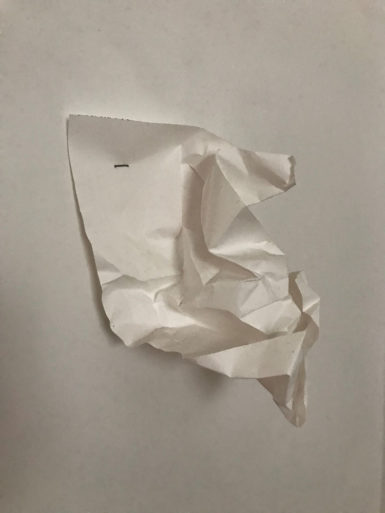
Fernanda Gomes, Untitled, 2018.
COURTESY THE ARTIST AND GALERIA LUISA STRINA, SÃO PAULO
Fernanda Gomes
Secession, Vienna
April 12–June 16
Fernanda Gomes channels the constructivist sense of form and play prominent in her Brazilian homeland but with a haunted sense of loss or at least uncertainty that can be hard to shake. Wood from old furniture along with commonplace materials like glass, paper, hair, cigarette butts, and many more come to seem monumental in works that like play like paintings and sculptures or, often, both. To defer to a few of Gomes’s own words as cited by a show description: “Painting, sculpture, architecture. Tradition of ruptures. Thought is plastic. Reflection dimensions, with multiple meanings. So many questions at the core of this investigation, light!” —A.B.
Havana Biennial
Various venues, Havana, Cuba
April 12–May 12
In the wake of the recent passing of Decree 349, a law signed in Cuba last April that stipulates who qualifies as an artist and where they can exhibit as determined by the country’s government, the official biennial, which carries the theme “The construction of the possible,” is already being contested by the artist-activist community—in February, a group of Cuban artists called on participants to stand against the decree. But the show will go on amid this controversy, and it will feature over 80 artists from some 60 countries. Several artist projects will be on view outside Havana as part of the biennial as well. —M.D.
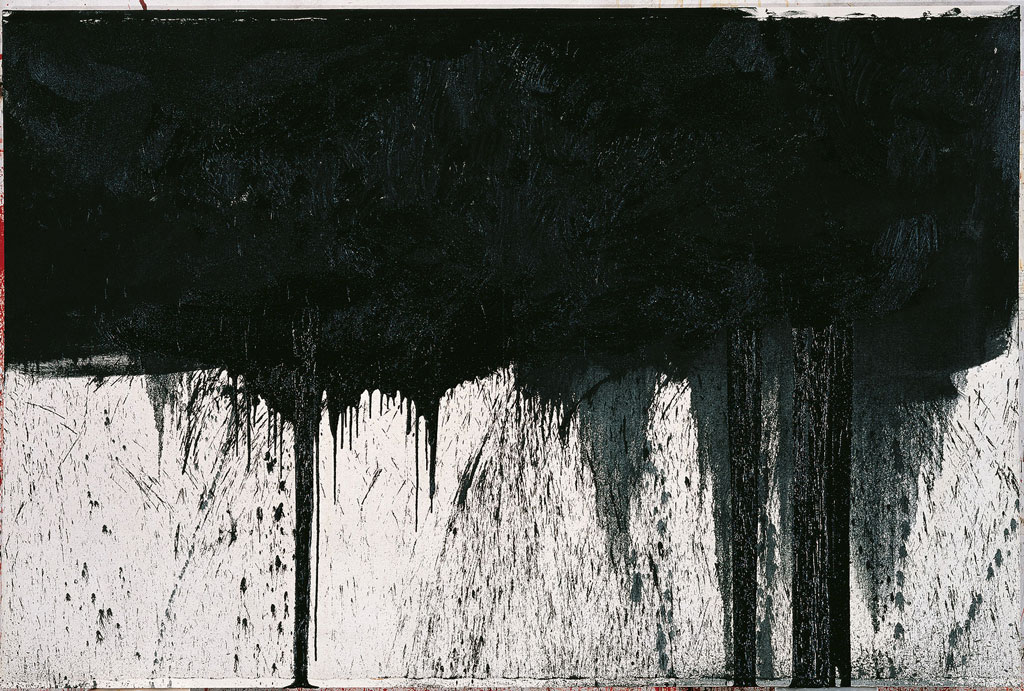
Hermann Nitsch, Kreuzwegstation (Stations of the Cross, 1991, from the series “The Black Cycle,” oil on white-primed jute.
ALBERTINA, WIEN. SAMMLUNG ESSL
Venice Biennale 2019
Various venues, Venice, Italy
May 11–November 24
“May You Live in Interesting Times,” the title for the group exhibition at this year’s Venice Biennale, is meant to encompass a lot. As conceived by Ralph Rugoff, the show’s curator (and director of the Hayward Gallery in London), it addresses colonialism via an allusion to a mistranslated Chinese curse, as well as the preponderance of fake news and uncertainty in the world today. If all that is not fully fleshed out in Rugoff’s show, it may well be in the Biennale’s many national pavilions. Highlights for this edition include Martin Puryear representing the United States, Natascha Süder Happelmann showing for Germany, and Charlotte Prodger repping Scotland. —A.G.
Hermann Nitsch
Albertina, Vienna
May 17–August 11
Hermann Nitsch may be best known for his performances related to the Viennese Actionism movement from the 1960s, many of which gesture at graphic violence and strange sexual desires, but this exhibition aims to offer an in-depth look at a lighter side of his work: his poured paintings. Made by letting large quantities of paint drip down and across his canvases, these works, too, allude to carnage, albeit in a more abstract way. On view in the show will be several decades’ worth of work done in that format. —A.G.
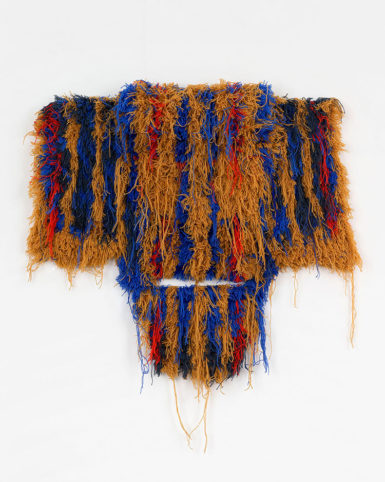
Caroline Achaintre, Herbert, 2018, hand-tufted wool.
CLAIRE DORN/COURTESY ART: CONCEPT, PARIS
“Caroline Achaintre: Permanent Wave”
21er Haus, Vienna
May 17–September 15
Caroline Achaintre’s latest outing explores the European customs of carnival and Mardi Gras. Citing horror and science fiction as influences, the artist uses traditional techniques such as tapestry and ceramic to craft foreboding-looking sculptures that resemble winged monsters and dripping carcasses. The resulting pieces: tapestries dripping with dyed wool, crumpled, figurative sculptures, and Rorschach-esque watercolors, many of which will be included here. —A.A.
“Appearance Stripped Bare: Desire and the Object in the Work of Marcel Duchamp and Jeff Koons, Even”
Museo Jumex, Mexico City
May 19–September 29
For this show, which promises to be a blockbuster, Museo Jumex brought in big talent: New Museum artistic director Massimiliano Gioni (as curator) and architect David Chipperfield (as exhibition designer). Marcel Duchamp and Jeff Koons may be separated by more than half a century, but according to Gioni, their work evidences “enigmas of invisibility and exposure, secrecy, and revelation.” Work by both also deals with commodification and materialism—themes likely to appear throughout the show in the form of Duchamp’s readymades and Koons’s sleek revisions of the same concept. —A.A.
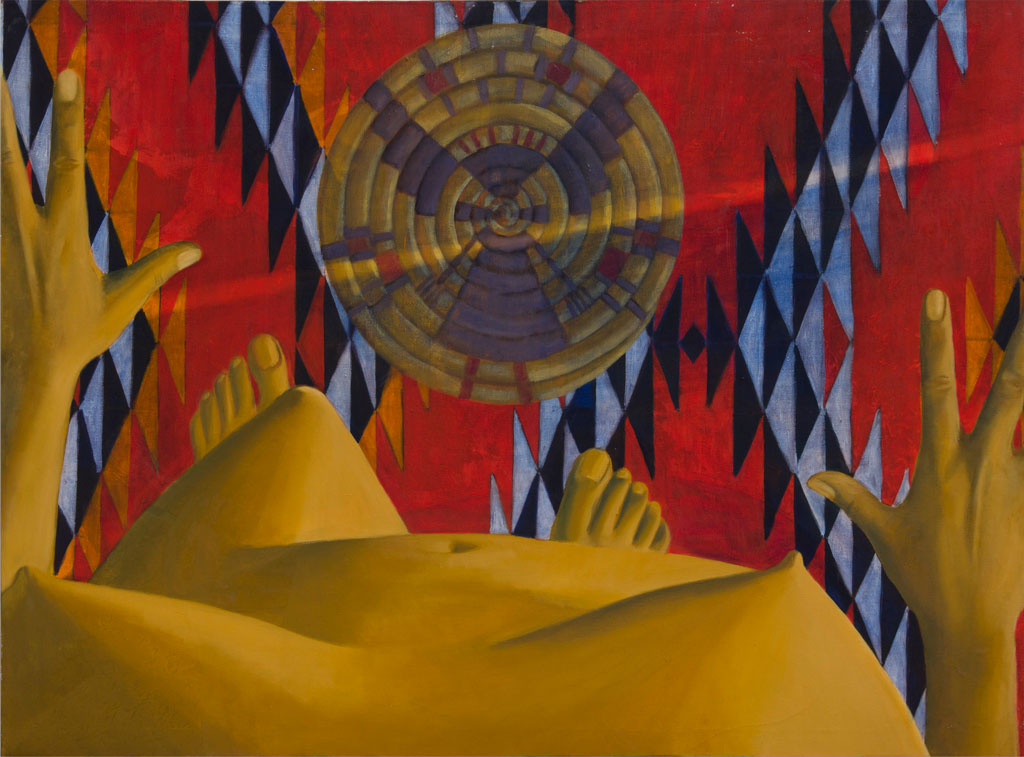
Luchita Hurtado, Untitled, 1969, oil on canvas.
JEFF MCLANE/COURTESY THE ARTIST
Luchita Hurtado
Serpentine Galleries, London
May 23–September 8
At 98, Hurtado is finally having her moment. Best known for her canvases that offer disorienting and dizzying perspectives on the female body (which in many cases is Hurtado’s own), she was one of the breakout stars from the 2018 Made in L.A. biennial at the Hammer Museum. This exhibition will be the artist’s first solo exhibition at an arts institution, and it will connect her historic work with recent pieces. Hurtado was born in Caracas, Venezuela, moved to New York as a child, and befriended leading members of the international avant-garde circles of the late 1930s and ’40s, including Man Ray, Isamu Noguchi, and Wifredo Lam. She later moved to Mexico City, San Francisco, and Taos, New Mexico, before settling in Los Angeles in 1951. Her practice has long been interested in the ways humans relate to the nature that is all around us and the cosmos, a through-line that intensified after seeing early images of planet Earth from space in 1946. —M.D.
Dora Budor
Kunsthalle Basel, Switzerland
May 24–August 11
In 2017 Dora Budor let loose a group of Leonardo DiCaprio impersonators at the Frieze New York art fair. It was a typical piece for the young New York–based artist, whose work often brings big-budget movies into the real world, by remaking and revising elements of classics, like an oversized head based on a plot element in Scanners and the famous falling frogs from the ending of Magnolia. Her latest show moves her work in a new direction: A release from the Kunsthalle Basel says that this show is informed by a “score” crafted from sound, dust, and data, and will involve the artist turning the exhibition space into “a reactive biotope.” —A.G.
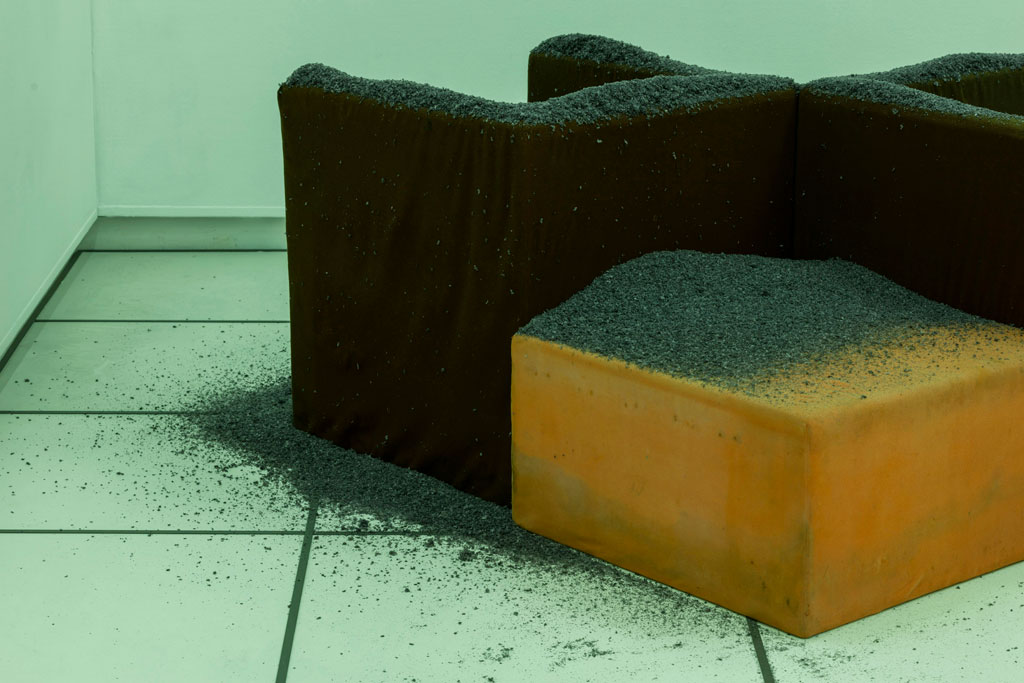
Dora Budor, Year Without A Summer (Panton’s Diversion), 2017, installation view at Louisiana Museum of Modern Art.
COURTESY THE ARTIST AND KUNSTHALLE BASEL
“Stephen Willats: Language of Dissent”
Migros Museum für Gegenwartskunst, Zurich
May 25–August 18
How does the world work? How are we connected? How do ideas travel, morph, and enter public consciousness? (Or not.) These are just a few of the grand questions that Stephen Willats, the pioneering British conceptualist, addresses in his art with verve, wry humor, and a gimlet eye. To put it simply: flow charts, photo murals, graphs, and the like have never looked so disarmingly smart, and Willats should be taught in business schools across the land. Migros’s director, Heike Munder, is helming this expansive survey, and the catalogue features John Kelsey, among others. What more could one ask for? —A.R.
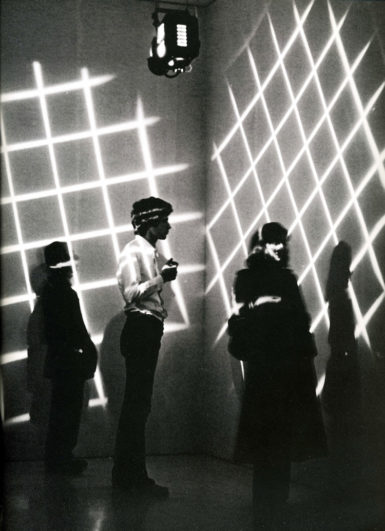
Gianni Colombo, After Structures, 1966–67, installation view at Galleria l’Obelisco, Rome, 1966.
ARCHIVIO GIANNI COLOMBO, MILANO
“Vertigo: Op Art and a History of Deception 1520–1970”
Museum Moderner Stiftung Ludwig Wien, Vienna
May 25–October 27
Eyes have been deceived for as long as they have scanned the world around them, and this show surveys some 450 years of artists working with the phenomenon to playful and perception-shifting effects. Of the 1960s-era vogue for Op art and kinetic art, an exhibition description states, “Often they were depreciatingly seen as too spectacular and thus superficial. Wrongly so, since Op art and kinetic art sharpen our awareness of the ambiguous nature of reality.” The artist list, conceived by curators Eva Badura-Triska and Markus Wörgötter, features contemporary artists that one might expect (Julio Le Parc, Bridget Riley, Victor Vasarely) along with older names that could be a surprise (Giuseppe Galli-Bibiena, Giovanni Battista Piranesi, Abbott Henderson Thayer). —A.B.
Oslo Biennial
Various venues, Oslo, Norway
Opens May 25
As it turns out, this year Venice isn’t the only major European city that will have stage a biennial in May. For the first time, the Norwegian capital will play home to the Oslo Biennial, which is being overseen by Eva González-Sancho, the former director of the Museo de Arte Contemporáneo de Castilla y León in Spain, and Per Gunnar Eeg-Tverbakk, the former director of the Kunsthall Oslo. Already, the biennial, which has yet to announce its artist list, has had a profound impact on the Norwegian art scene—it has opened 60 new studios for artists based in Oslo. —C.S.
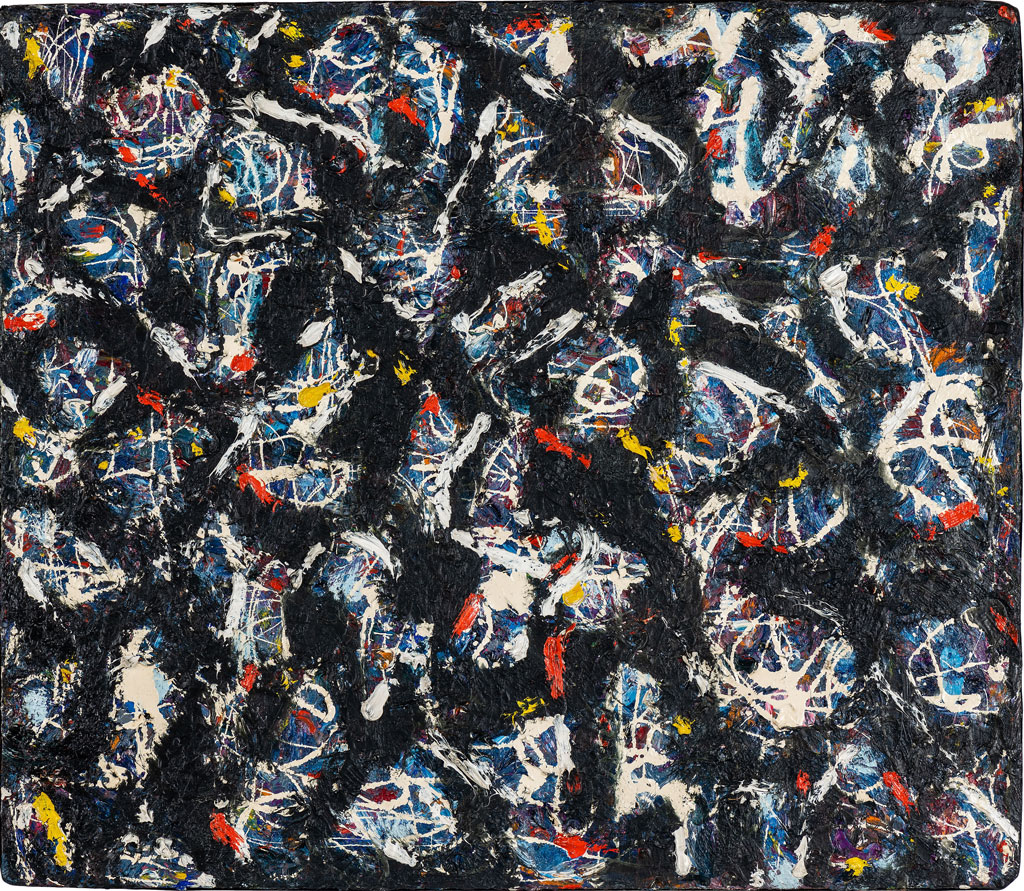
Lee Krasner, Abstract No. 2, 1947.
©THE POLLOCK-KRASNER FOUNDATION/IVAM CENTRE, SPAIN
“Lee Krasner: Living Colour”
Barbican Centre, London
May 30–September 1
In the first European retrospective in more than 50 years for Lee Krasner, some 100 works spanning her full career—from early self-portraits to grand, vibrantly hued Abstract Expressionist paintings—will be on view in an arrangement curated by Eleanor Nairne. The show’s checklist also includes charcoal drawings, photographs, and designs for window displays and film—all in service of paying tribute to an artist historically known as the widow of Jackson Pollock but now revered in her own right. —B.A.M.
Frank Bowling
Tate Britain, London
May 31–August 26
Following a survey that traveled to Ireland, Germany, and the United Arab Emirates, Frank Bowling’s first major retrospective will take up residence in England.
Over his five decades as a painter, Bowling has worked to synthesize globalist politics and formal experimentation in the form of Abstract Expressionist–like maps that place Africa and South America at the center of the world. This retrospective will include some of those works as well as early figurative paintings and more recent works that feature pours of exuberantly colored paint flowing down canvases. —A.G.
[ad_2]
Source link

